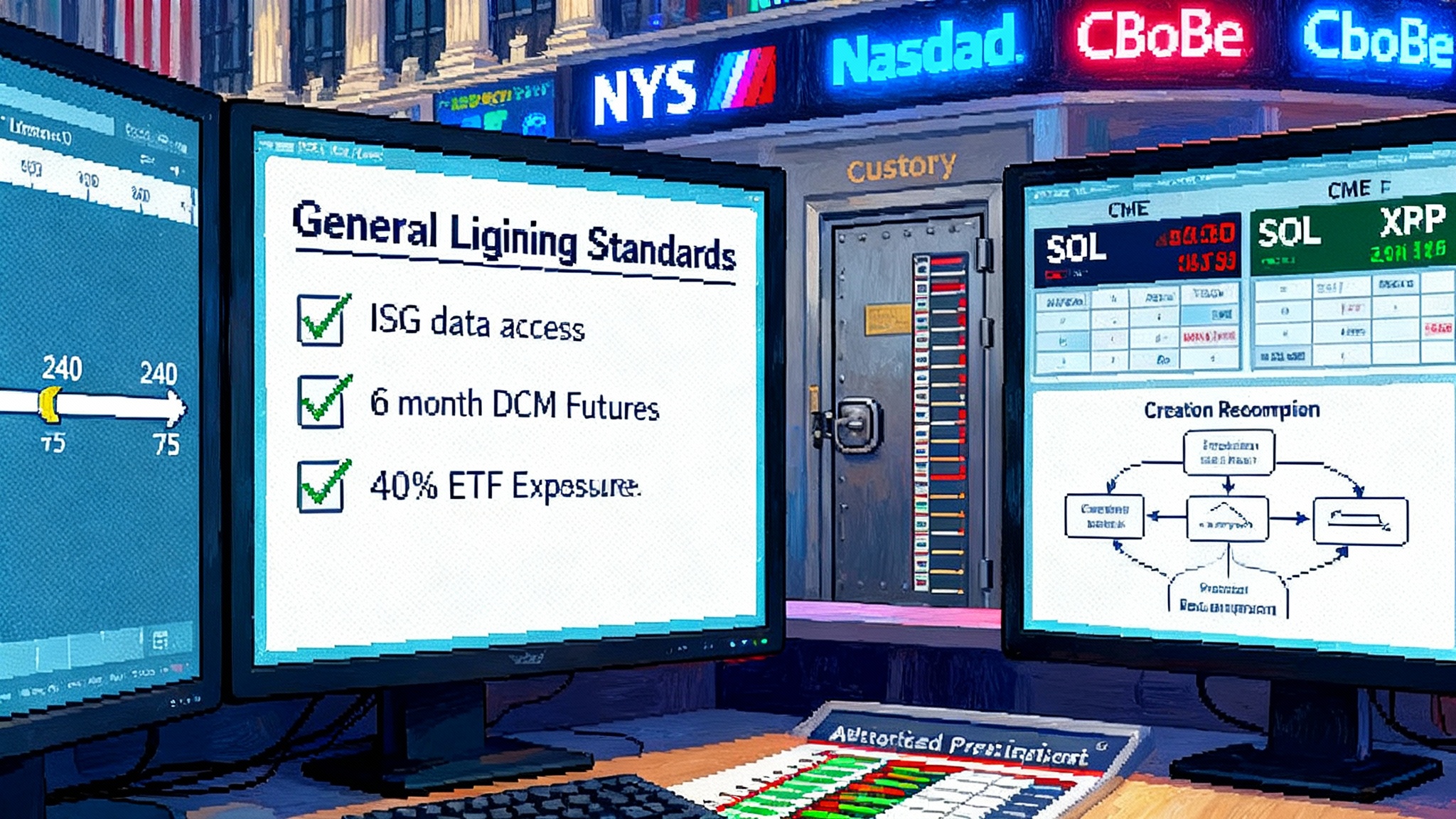DBS, Franklin Templeton and Ripple make MMFs tradable on XRPL
DBS will list Franklin Templeton’s sgBENJI on the XRP Ledger alongside Ripple’s RLUSD stablecoin, giving accredited and institutional clients a regulated way to trade, pledge and sweep cash into a yield‑bearing fund with on‑ledger settlement and bank‑grade controls.

The news that changes the cash leg of crypto
In late September 2025, Singapore’s DBS Bank said it will list Franklin Templeton’s sgBENJI token next to Ripple’s RLUSD stablecoin on DBS Digital Exchange, with sgBENJI issued on the XRP Ledger. Accredited and institutional clients will be able to trade between the two, earn fund yield, and potentially post sgBENJI as collateral for credit and repo lines. DBS framed this as a step toward 24/7 portfolio rebalancing into a conservative, yield‑bearing asset with settlement in minutes rather than days, all under a regulated perimeter. The bank published the plan in its newsroom; see the DBS newsroom announcement for core details.
Two ingredients stand out. First, sgBENJI represents shares in Franklin Templeton’s onchain U.S. dollar short term money market fund, a conservative portfolio of Treasury bills, repurchase agreements and cash. Second, RLUSD is Ripple’s U.S. dollar stablecoin. Putting both instruments on the same ledger, under a single bank‑controlled workflow for onboarding, custody, trading and credit, is the point. It creates a clean base pair for cash and cash equivalents that financial desks can actually use at scale. For context on how stablecoin rails are evolving, see our look at how Tether’s rail switch is remaking payments.
Why a stablecoin plus a tokenised fund on the same ledger is different
Many tokenisation pilots have moved slowly because they stopped at proof‑of‑concept. You could buy a tokenised fund unit in one walled garden, hold a stablecoin in another, and never compose them programmatically. What DBS, Franklin Templeton and Ripple are doing is different in three specific ways:
-
Composability on a single settlement layer. XRPL, short for XRP Ledger, natively supports issued currencies, a built‑in decentralised exchange, escrow and low‑cost payments. When both the stablecoin and the fund token live on the same ledger, treasury teams can script atomic flows between the two without moving across chains or relying on wrapped assets. That cuts operational risk and lowers the chance of settlement breaks.
-
A regulated venue that speaks bank. DBS Digital Exchange is a bank‑operated platform that onboards accredited and institutional clients with know‑your‑customer checks, provides qualified custody, and integrates with the bank’s treasury and credit functions. This is not a proof‑of‑concept sandbox. It is a venue where a client can hold, trade, pledge and report within the policies their auditors require.
-
A fund designed to be held digitally. Franklin Templeton has spent several years building transfer agent and record‑keeping hooks for onchain money market fund shares. sgBENJI is not a synthetic representation. It is a token tied back to the fund’s official share registry, which lets the token be treated like the underlying security for purposes of ownership, yield accrual and corporate actions. This mirrors our exploration of an onchain golden record for corporate actions.
The net result is simple to describe and powerful in practice: a treasurer, a broker‑dealer desk or a lender can move dollars into RLUSD, swap to sgBENJI in seconds, earn yield while idle, then swap back to RLUSD to make a payment or meet margin. The entire loop lives on one ledger, with one set of controls.
The immediate primitives this unlocks
On‑chain repo with bank‑grade collateral
Repurchase agreements, known as repo, are the plumbing of short‑term funding. One party sells a high‑quality asset and agrees to repurchase it later at a slightly higher price. The spread is the financing rate. With sgBENJI on XRPL and bank custody, repo can be run as an on‑ledger workflow where the fund token is posted as collateral and RLUSD is the cash leg. A tri‑party setup becomes programmable. The ledger enforces who can touch the collateral and when. Haircuts, eligibility lists, substitution rights and auto unwind can be expressed as rules rather than emailed term sheets.
Two features matter for risk control. First, the fund token is conservative collateral: it represents a diversified money market fund rather than a single bond. Second, settlement is near‑instant, so collateral moves and cash moves can be atomically linked. That reduces intraday exposure to failed deliveries.
Intraday credit and T0 settlement
Credit officers often grant intraday lines that must be repaid by close of day. On‑ledger transfers make those intraday cycles shorter and more predictable. A desk can post sgBENJI at 10:02, draw RLUSD at 10:03, and unwind at 14:15. There is no courier, no manual wire queue, no batch window. This is not just faster. It is more controllable, because each hop is in a ledger state machine with audit history.
Treasury cash management that behaves like software
Corporate treasurers usually face a clumsy trade‑off. Keep cash idle for payments or sweep into a fund that takes a day or more to settle. With RLUSD and sgBENJI on the same ledger, a treasurer can set rules like: keep 2 percent of balances in RLUSD for same‑day payments and sweep the rest into sgBENJI at a set time each day. If a large payable arrives, the sweep reverses programmatically. The fund accrues yield while idle balances wait. It is the same operational pattern as a traditional bank sweep program, but the state changes are onchain and auditable to the second. For a payments‑side comparison, see how Visa switches on stablecoins.
Programmatic duration laddering
Some teams will want slightly longer duration than an overnight repo or a same‑day sweep. With onchain funds, you can create rules that spread balances across a ladder of conservative instruments. Think 70 percent in sgBENJI, 20 percent in a tokenised Treasury bill fund with a 3 month duration, 10 percent in cash. That ladder can be implemented with policy code and enforced by whitelists. Changes are gated by approvals and logged.
How the flow works, end to end
Here is a concrete example to make the mechanics tangible.
- A market maker onboarded to DBS Digital Exchange holds a balance of RLUSD.
- The desk sees weekend volatility rising. It wants to park excess cash while staying onchain.
- It places a trade on DBS Digital Exchange to swap RLUSD for sgBENJI. The swap settles in minutes. The desk now holds a token that accrues the fund’s daily yield.
- A client request arrives midday Monday. The market maker needs to post dollar collateral on a third‑party venue that accepts RLUSD.
- The desk swaps back from sgBENJI to RLUSD and ships RLUSD to the venue. If it needs a credit line, it can post sgBENJI to DBS as collateral and draw RLUSD against it for a few hours.
- At day’s end, the credit line unwinds and the desk returns to its target allocation. All movements are booked, timestamped and match the ledger.
This is the cash leg behaving like software. There is no file upload, no custodian email chain, and no waiting for a transfer window to open. Desk limits, whitelists and role‑based approvals still apply. They are enforced by the venue and the ledger rather than by spreadsheets.
Why Asia is first, and how the United States can follow
Singapore has been building a playbook for tokenised finance through regulatory experiments and industry consortia. The regulator has encouraged controlled pilots where banks serve as gateways, custody stays in regulated hands and tokenised instruments inherit the legal character of the underlying assets. That is the pattern DBS is using now.
The United States can replicate the architecture with a few adaptations.
-
Legal wrapper. Franklin Templeton’s onchain fund is an investment company registered under the Investment Company Act of 1940. United States broker‑dealers and banks can distribute share classes using transfer agent links to record ownership on a public ledger, while keeping all investor protections. The token remains a representation of a regulated security.
-
Stablecoin policy. A stablecoin used as the cash leg must be issued under a regime that satisfies bank examiners and broker‑dealer controls. Ripple’s RLUSD is positioned for institutional payments, and the issuer will need to offer detailed attestations on reserves, redemption windows and operational resilience. If a bank trusts the token’s redemption and liquidity management, it can treat RLUSD as a programmable settlement asset for client flows.
-
Venue design. A bank or a broker‑dealer can run a walled‑garden venue similar to DBS Digital Exchange. Onboarding uses existing know‑your‑customer, suspicious activity monitoring and sanctions screening. Trading takes place on‑ledger but access is controlled by whitelists. Custody is qualified. This preserves the compliance posture while unlocking onchain settlement and composability.
-
Credit and collateral. The next step after trading is lending. A United States bank could accept a tokenised fund share as collateral if its credit policy recognises the underlying fund, sets conservative haircuts and defines eligibility criteria. That is familiar work for collateral teams.
The Asian playbook is not a detour from regulation. It is regulation applied to programmable assets. The result is a blueprint that a United States bank can copy: keep the rules, change the rails.
What this signals for liquidity migration in Q4 and beyond
Three migration paths will matter over the next quarter.
-
From centralised crypto venues to bank‑operated rails. Market makers and funds that keep cash on crypto exchanges for speed will shift idle balances into bank‑supervised, on‑ledger instruments. The combination of RLUSD and sgBENJI gives them speed without sacrificing yield or custody standards. Expect balances to migrate over weekends and into month‑end reporting cycles first, where onchain settlement and audit trails are most valuable.
-
From traditional treasury operations to programmable sweeps. Corporate treasurers care less about which chain is used and more about predictability. If a bank can offer a policy‑driven sweep that moves surplus cash into a conservative tokenised fund and back again within minutes, treasurers will test it for a subset of balances that do not require intraday wires. The win is working capital efficiency that is observable to auditors in real time.
-
From bilateral repo to programmable tri‑party. Dealers and money funds can codify eligibility lists, haircuts and substitution rights as ledger rules. The operational gains are strongest for intraday and overnight funding, where manual processes add the most friction. When a bank stands behind the collateral workflow, the jump from a spreadsheet to a smart policy is not a leap of faith.
There will be skepticism. Some will say this is just a new wrapper. The better view is that it is a new settlement fabric for the same conservative instruments institutions already use. The fabric is faster, the state is shared and the controls are programmable.
What to do now if you are a bank, a broker‑dealer or a treasurer
-
Start a narrow pilot. Pick one client segment, one venue and one pair: RLUSD for cash, sgBENJI for yield. Define a dollar cap and a 90‑day window. Use existing approval flows and document exceptions.
-
Map your controls. Translate your know‑your‑customer and sanctions screening into whitelists. Define who can authorise swaps and collateral pledges, and under what limits. Automate alerts for role changes and out‑of‑policy events.
-
Configure haircuts and stop‑losses. Treat sgBENJI as you would a conservative fund in your collateral schedule. Implement a conservative haircut and an automatic unwind if fund price deviates beyond a threshold or if token transfers are paused.
-
Design the reporting spine. Your auditors and regulators will ask how you know what happened. Decide which ledger events you will archive, how you will reconcile them to books and records, and how you will present the flow in management reports.
-
Test the weekend. The promise of 24/7 only matters if you use it. Run a weekend cycle where you sweep into sgBENJI on Friday evening and back to RLUSD on Sunday night. Measure how long each hop takes, who approves it and how alerts behave.
Why XRPL is a fit for this specific job
The XRP Ledger is not a general‑purpose kitchen sink. It is a payments‑first ledger with native support for issued currencies, a built‑in decentralised exchange, low transaction costs, finality measured in seconds and account‑level controls that help with whitelisting and compliance. For a bank pairing a stablecoin and a tokenised fund, those ingredients matter. The ledger does not need to do everything. It needs to settle quickly, reliably and predictably.
Ripple has positioned RLUSD as a settlement asset for institutions and has pitched the pair with sgBENJI as a rebalancing tool that works in minutes and around the clock. The company’s release highlights two near‑term steps: listing sgBENJI alongside RLUSD on DBS Digital Exchange and exploring the use of sgBENJI as collateral for credit at the bank or on third‑party platforms where DBS acts as custodian. See Ripple’s RLUSD and sgBENJI update for the company’s statement.
The frictions that still need grinding down
-
Investor segmentation. This is for accredited and institutional investors. That is appropriate for the asset type and the venue. It also means retail liquidity will not arrive on day one.
-
Interoperability. Composability is strongest when everything you need is on one ledger. In practice, treasurers may hold balances across chains and banks. Standardising messages and controls across venues will take more than one quarter.
-
Operational risk. The token inherits the fund’s profile, but it also inherits platform risk. Banks will want to see well‑documented pause procedures, key management and reconciliation flows from token to register.
-
Legal plumbing. United States broker‑dealers will need clear guidance on custody of tokenised securities, treatment under customer protection rules and capital charges for on‑ledger collateral. These are solvable questions, but they are not overnight changes.
The bigger picture
We are watching the cash layer of markets move onchain in a regulated way. Money market funds are already the operating system of short‑term liquidity in traditional finance. Stablecoins are already the operating system of value transfer in crypto. Putting them together on a bank‑run venue with a single settlement ledger is not a headline for its own sake. It is a path for capital to move at software speed without leaving the regulatory perimeter.
If you want a simple metaphor, think of it like upgrading from a patchwork of toll roads to a single express lane that uses your car’s transponder everywhere. You still drive the same car, obey the same speed limits and pay the same taxes. You just get where you are going faster, with fewer bottlenecks and better telemetry.
Conclusion
DBS listing Franklin Templeton’s sgBENJI alongside Ripple’s RLUSD on the XRP Ledger is not a marketing stunt. It is a functional pairing of a bank‑grade stablecoin with a tokenised money market fund on one programmable rail. That pairing makes repo programmable, sweeps and rebalancing practical, and intraday credit safer. Asia’s playbook shows how a bank can keep its controls and still embrace onchain settlement. The United States can follow by wrapping the same instruments in the same policies and letting the rails change underneath. Over the next quarter, expect liquidity to test these rails during weekends, month ends and market stress. If the pipes hold, balances will not just visit. They will stay.








